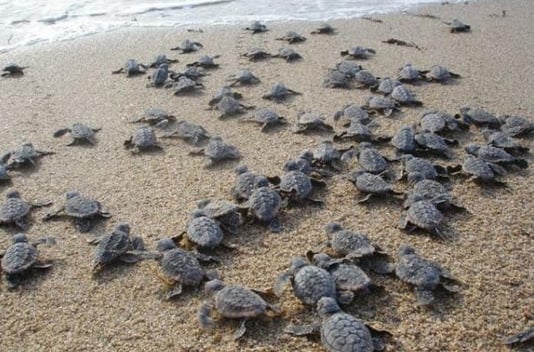New Smyrna Beach Turtle Season
Sea turtle nesting season starts May 1.
Sea turtle nesting season officially starts May 1, but somebody forgot to tell the turtles. Volusia County-managed beaches already have three sea turtle nests. The first nest was laid by a leather back sea turtle on March 29, the earliest recorded sea turtle nest on county-managed beaches. The other two nests were laid by Kemp’s ridleys, the world’s smallest and most endangered species of sea turtle.
 With water temperatures warming up quickly, hundreds of sea turtles will be emerging from the surf to lay eggs on the beach in the next few months.
With water temperatures warming up quickly, hundreds of sea turtles will be emerging from the surf to lay eggs on the beach in the next few months.
After incubating in the sand for about two months, tiny hatchlings will break free of their eggshells and make an often treacherous crawl to the ocean, dodging predators, holes, trash and beach furniture. Tragically, some will also be led into harm’s way by beachfront lighting.
Only about one in 1,000 to 10,000 hatchlings will make it safely to sexual maturity, which may take 10 to 25 years depending on the species.
Jaymie Reneker, Volusia County's sea turtle Habitat Conservation Plan program manager, wants to improve those odds, and she could use the public’s help.
“Our goal is to make Volusia County beaches a safe and inviting place for humans and sea turtles,” she said. “We encourage residents and visitors alike to respect our wildlife. The largest impacts even a single person can make are keeping our beaches clean, dark and flat. We encourage everyone to let the night provide the light on our coastline.”
Female and hatchling sea turtles can be affected by artificial lighting. Typically, female sea turtles will choose dark, naturally moonlit beaches to deposit their eggs. After emerging from their nest, hatchling sea turtles navigate to the sea by using the brightest horizon of the night sky, which should be the moon reflecting off the water.
“Visitors and residents can help by turning lights off when they are not in use, using blinds to block interior lights and redirecting lights away from the beach,” Reneker said. “This will help keep sea turtles out of danger all season long.” The county’s Environmental Management Division works with beachfront property owners throughout the year, educating them about the sea turtle lighting ordinance. During nesting season, residents are required to shield, redirect or turn off lights so they don’t shine on the beach. The Habitat Conservation Plan program provides a variety of educational materials to beachfront property owners at no cost. If you would like to request free educational materials, visit www.volusiaseaturtles.org.

Following the 2022 hurricane season, beach recovery is still underway and will continue through the sea turtle nesting season. Coordination of all construction projects is being handled by staff from Volusia County’s Environmental Management and Coastal divisions alongside partners from the Florida Department of Environmental Protection and Florida Fish and Wildlife Conservation Commission. For questions about beach project permits, visit www.volusia.org/beachcleanup.
Residents and visitors can also help save sea turtle lives by following these tips on the beach:
- Do not touch or disturb sea turtles or their nests. It’s important that hatchlings make their own way to the ocean.
- Do not disturb the dune system or plants. Use designated beach access points and do not walk on the dunes.
- When driving at the beach, use the designated traffic lanes and parking areas. Beach driving hours are from 8 a.m. to 7 p.m. throughout the nesting season, tide permitting.
- Do not use flash photography at night.
- Do not use cellphones to light your way at night.
- Use only red LED flashlights; they are less visible to turtle eyes.
- After a day at the beach, flatten sandcastles, fill in holes, and take your chairs and equipment with you. This is an easy way to reduce obstacles faced by sea turtles.
- Dispose of trash and recyclables in proper receptacles. Trash left on the beach can attract predators that impact sea turtle nests.
- Do not use fireworks. They are not only prohibited on the beach at all times, but they can be disruptive to turtles.
- If you see a nesting adult sea turtle or hatchlings making their way to the ocean, admire them from a safe distance. Stand far away, remain calm, and quietly enjoy this special experience. If a turtle appears to be in immediate danger, notify a lifeguard or Beach Safety officer or call the Florida Fish and Wildlife Conservation Commission at 888-404-3922.
Nesting season runs through Oct. 31. On average, more than 580 nests are laid in Volusia County. Last year’s season was the highest nesting season on record, with 1,427 nests counted.
For more information about Volusia County’s sea turtle program, call 386-238-4668 or visit www.volusiaseaturtles.org. For questions about sea turtle-friendly lighting, call 386-238-4773.
Credits to: Pat Kuehn, CPRC Volusia County Community Information Specialist
